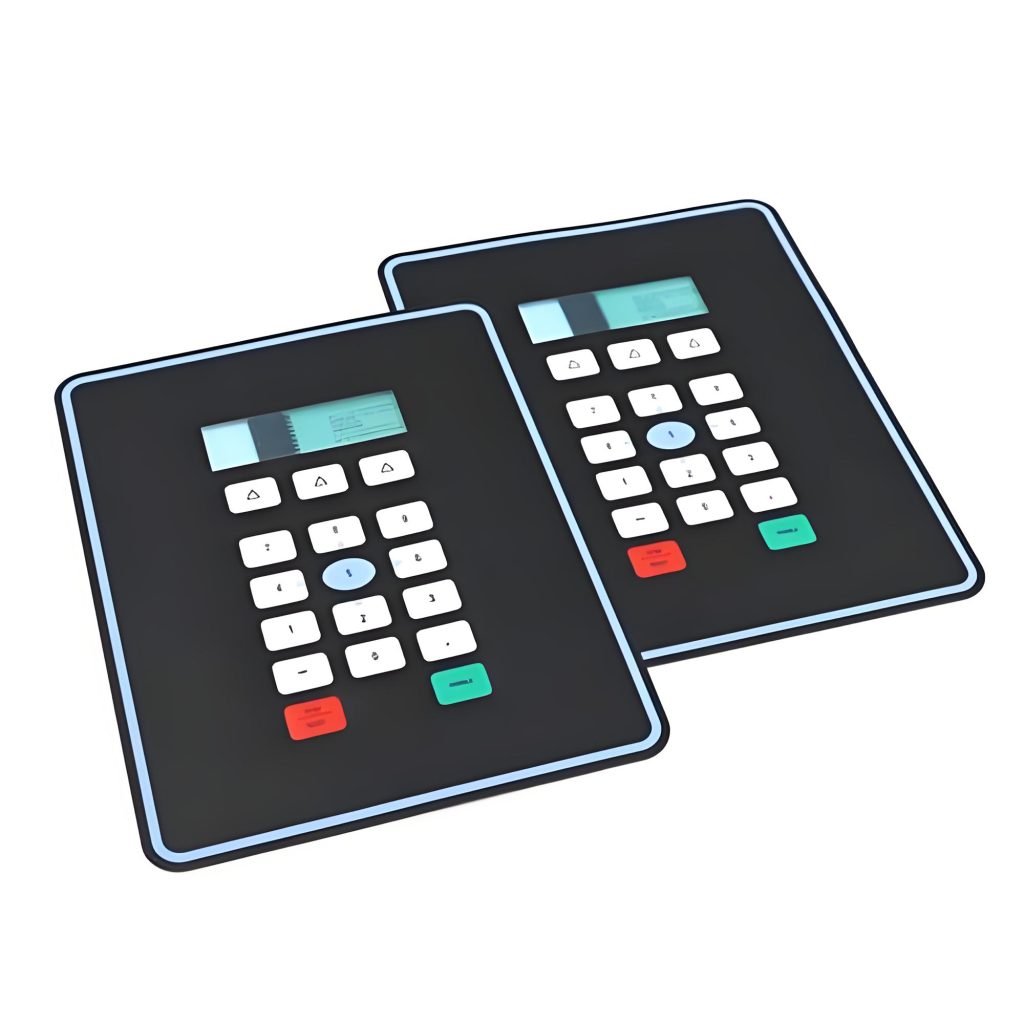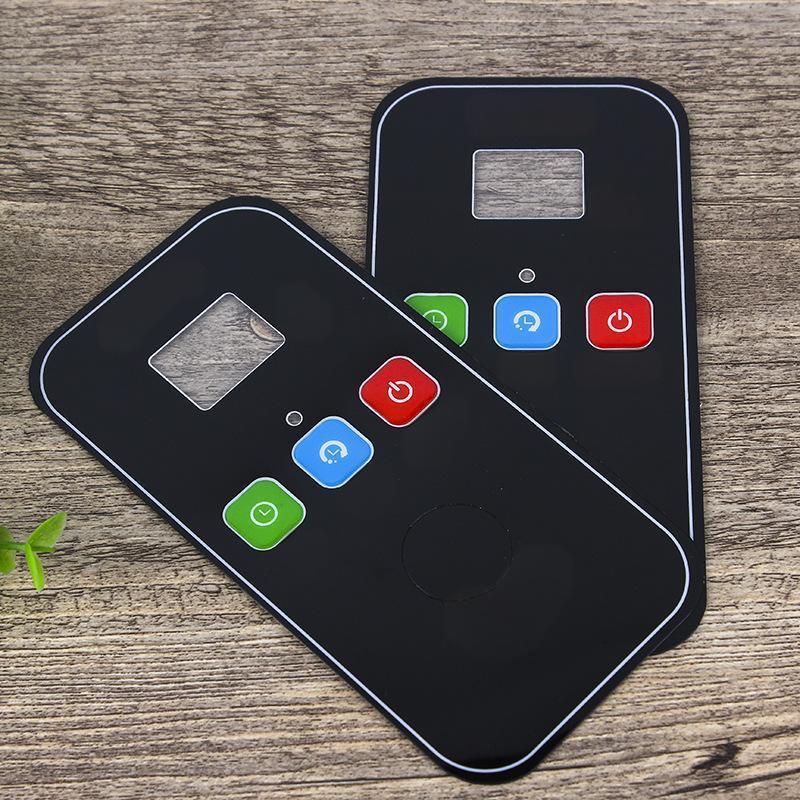
How to design membrane switch?
How to design membrane switch?
A membrane switch is an electronic switch composed of multiple layers of thin film materials, usually including a panel layer, a circuit layer, an isolation layer, and an adhesive layer. The panel layer is usually made of materials such as polyester film or polycarbonate, and has good wear resistance, corrosion resistance, and insulation. The circuit layer is made of materials such as conductive ink or metal foil, which is used to realize the conductive function of the switch.
What is a membrane switch?
A membrane switch is an operating system that integrates key functions, indicating elements, and instrument panels. It consists of four parts: a panel, an upper circuit, an isolation layer, and a lower circuit.

When the membrane switch is pressed, the contact of the upper circuit deforms downward and contacts the plate of the lower circuit. After the finger is released, the contact rebounds, the circuit is disconnected, and a signal is triggered.
How to design membrane switch?
The following steps and considerations need to be followed to design a membrane switch:
- Determine the design requirements: First, clarify the use scenarios and functional requirements of the membrane switch. Membrane switches are widely used in electronic communications, medical equipment, automotive industry, and household appliances. They are waterproof, dustproof, and have long life.
- Material selection: The membrane switch is mainly composed of a panel, an upper circuit, an isolation layer, and a lower circuit. The panel material is usually made of highly tough PET or PC translucent colorless sheets, and the thickness is generally less than 0.25mm. The upper and lower circuits are made of polyester film (PET), and conductive silver paste and conductive carbon paste are screen-printed to ensure conductive performance.
- Structural design: The structural design of the membrane switch should be rigorous, beautiful in appearance, and good in sealing. When the membrane switch is pressed, the contacts of the upper circuit will deform and contact the plates of the lower circuit. After the finger is released, the contacts rebound, the circuit is disconnected, and the signal is triggered.
- Button design: The design of the button needs to consider the convenience of operation and aesthetics. If the button is too small, it is difficult to operate, and if it is too large, it affects the appearance. When the button is raised, choose a shape with rounded corners such as a rectangle, circle, ellipse, etc.
- Text and pattern design: The text and pattern are directly marked on the color block of the function button, which is easy to identify and adaptable.
- Testing and optimization: After completing the preliminary design, functional testing and user experience testing are carried out to ensure the stability and user-friendliness of the switch.
What is the structure of a membrane switch?
A membrane switch is an electronic switch that integrates functions such as buttons, indicating elements, and instrument panels. Its basic structure includes the following parts:
- Panel: The panel is the “outer coat” of the membrane switch, and it plays a role of identification and decoration through different colors, patterns, and button shapes. Therefore, the selected material must have the characteristics of high transparency, high ink adhesion, high elasticity, and anti-folding.

- Surface adhesive: The surface adhesive layer is used to tightly adhere the panel to the upper circuit, usually using a strong double-sided adhesive with a thickness of 0.05-0.15mm.
- Upper circuit: The upper circuit is an electrical component of the membrane switch, usually formed by printing conductive materials on polyester film (PET). The upper circuit plays the role of a contact point necessary for the switch to close.
- Isolation layer: The isolation layer is located between the upper circuit and the lower circuit, and plays the role of insulation and bonding. Generally, double-sided adhesive with a PET substrate is used, with a thickness of 0.1–0.25mm.
- Lower circuit: The lower circuit corresponds to the upper circuit and is also formed by printing conductive materials on polyester film, acting as another contact for the switch closure.
- Adhesive: The adhesive layer is used to fix the membrane switch on the device. Usually, a strong double-sided adhesive that can adhere tightly to the adhesive surface is selected.
What are the dimensions of membrane switch?
The size range of membrane switches is wide, and common sizes include 4.24.80.55mm, 440.5mm, etc. The size of membrane switches can be customized according to specific needs. The common size range is wide, and the specific size can be determined according to the application scenario and design requirements.
What material is a membrane switch made of?
Membrane switches are mainly made of the following materials:
- Conductive film: Conductive film is the core component of membrane switches. It is usually made of materials such as silver paste or carbon paste to realize the conduction and disconnection of circuits. Silver paste circuits are widely used due to their good conductivity and stability.
- Insulating film: Insulating film is used to isolate conductive film to prevent circuit short circuits. Common insulating materials include plastic films such as polycarbonate (PC) and polyester (PET).
- Elastic substrate: The elastic substrate provides the elasticity and durability of the membrane switch. Common elastic substrate materials include rubber, silicone, etc.
- Interlayer glue: The interlayer glue is used to fix the panel and circuit layer to ensure that the switch will not loosen during use.
- Adhesive backing: The adhesive backing is used to fix the membrane switch to the device.
The manufacturing process of the membrane switch includes the following steps:
- Drawing the panel diagram and FPC circuit diagram: Use design software to draw the panel and FPC circuit diagram.
- Printing contact circuit: Print the contact circuit with conductive paste on polyester film.
- Assembly: Assemble the printed contact circuit, interlayer glue, upper circuit, isolation layer, lower circuit and adhesive backing together to form a complete membrane switch.
What is an example of a membrane switch?
- Medical equipment: Membrane switches are widely used in medical equipment, such as sphygmomanometers, electrocardiographs, etc. By pressing or touching the membrane switch, the switching and setting functions of the medical equipment can be realized, while improving the accuracy and reliability of the equipment.
- Instruments: Membrane switches are widely used in the control panels of instruments to provide interactivity and functionality.
- Industrial control: In the field of industrial control, membrane switches are often used as equipment controllers to monitor the production process.

- Home appliances: Membrane switches are widely used in the field of home appliance control, such as televisions, air conditioners, washing machines, etc. By pressing or touching the membrane switch, the functions of switching, adjusting, and setting the home appliances can be realized.
- Automotive electronics: Membrane switches are also widely used in the field of automotive electronics. It can not only realize the functions of switching, adjusting, and setting automotive electronic equipment.
- Communication: Membrane switches are also used in communication equipment, such as mobile phones, PHS, cordless phones, etc.
- Mechanical equipment: In mechanical equipment, membrane switches are used in various control panels to provide operation and display functions.
- Rail transit: In the field of rail transit, membrane switches are used in control panels and indication systems to ensure the convenience and safety of operation.
- Smart toys: Membrane switches are also widely used in smart toys to provide a user-friendly interactive experience.
- Computers and office systems: In office systems such as computers and telephones, membrane switches are used for operation and display functions.
As an important electronic input and control interface, the design process of membrane switches needs to comprehensively consider multiple aspects such as appearance design, material selection, and circuit design. When designing a membrane switch, appropriate materials and processes should be selected to ensure that the membrane switch has good performance and reliability.

Know the Difference between Tactile and Non-Tactile Membrane Switching
When selecting the appropriate interface for a product, it can be wise to understand the differences between tactile and non-tactile membrane switches so that the engineer and the purchaser make a better decision. They are both very common in medical equipment, domestic appliances, and industrial equipment, though they do not present the same user experience. ...

Step-by-Step Guide to Selecting the Right Membrane Switch for Your Product
It is not easy to choose the appropriate interface for an electronic device with the number of various types of membrane switches. This is a basic, stepwise analysis to help product designers and manufacturers select the optimal choice. Step 1: Determine your Application Requirements Begin by making a list of locations where switches are used, ...

Top Membrane Switches for Home Electronics Projects in 2025
You can elevate your home electronic membrane switch project in 2025 with standout models such as the 4×4 Matrix 12 Keys Keypad from SOUSHINE, the rgb-enabled strip switches from Molex, and custom graphic switches by Panasonic. These switches offer slim profiles and reliable performance, making them easy to integrate into your DIY setup. You gain ...
Contact us online